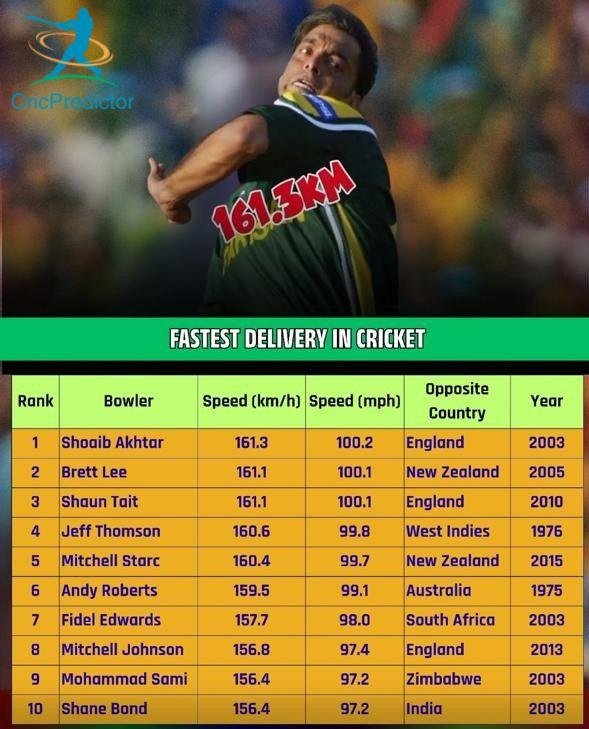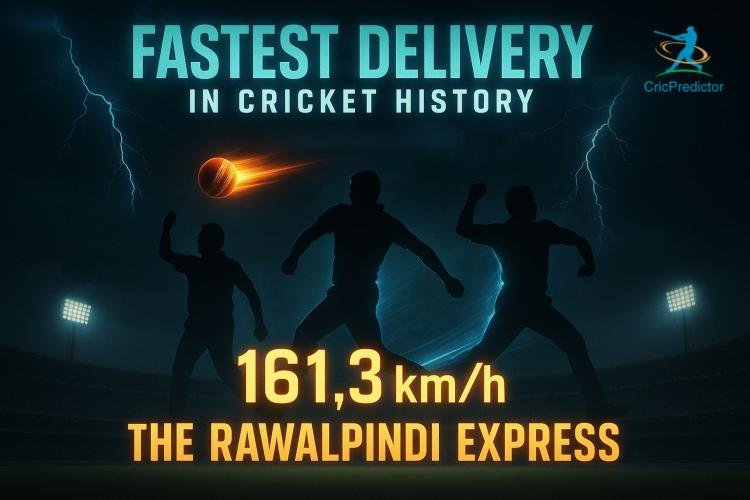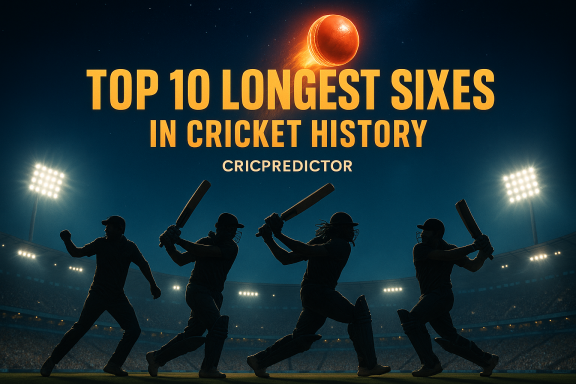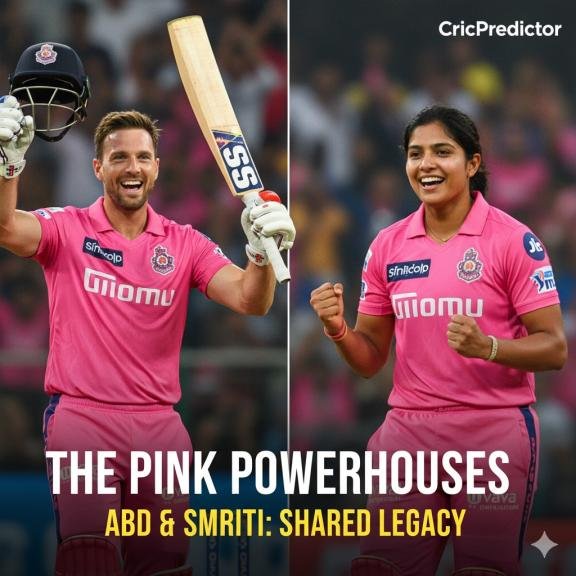
🏏 Fastest Delivery in Cricket History: The Speed Demons of the Game

⚡ Introduction: When Speed Meets Skill
Cricket isn’t just about line and length — it’s about fear, adrenaline, and the art of pure pace. Few sights excite fans more than a bowler charging in at full speed and hurling a 160 km/h thunderbolt past a startled batter.
Over the years, a select few bowlers have pushed the boundaries of human performance — men like Shoaib Akhtar, Brett Lee, Shaun Tait, Jeff Thomson, and Mitchell Starc — each etching their names in history with lightning-fast deliveries that redefined what was humanly possible on a cricket field.
But how did these bowlers achieve such speeds? What technologies recorded them? And who stands as the undisputed king of pace? Let’s dive into the story of cricket’s fastest ever.

🥇 1. Shoaib Akhtar – 161.3 km/h (Pakistan vs England, 2003)
Nickname: The Rawalpindi Express
Match: ICC Cricket World Cup 2003, Cape Town
Opponent: England
Speed: 161.3 km/h (100.2 mph)
Shoaib Akhtar, the undisputed king of speed, changed fast bowling forever when he delivered a 161.3 km/h thunderbolt against England’s Nick Knight during the 2003 World Cup. The ball, registered by an ICC-approved speed gun, became the fastest ever recorded in international cricket — a record that still stands.
What made Shoaib unique:
- Exceptionally explosive run-up and long stride that built immense kinetic energy.
- Tremendous lower-body strength, enabling powerful drive through the crease.
- Shoulder rotation and whiplash wrist action that created devastating release speed.
- Fierce mental aggression — he bowled as if every delivery was a duel of pride.
💡 Trivia: Akhtar’s average speed during that spell was 157 km/h — the fastest sustained spell ever documented in World Cup history.
🥈 2. Brett Lee – 161.1 km/h (Australia vs New Zealand, 2005)
Nickname: Binga
Match: Australia vs New Zealand, Napier, 2005
Speed: 161.1 km/h (100.1 mph)
Brett Lee, the poster boy of Australian pace, combined elegant technique with explosive speed. His 161.1 km/h delivery against New Zealand made him the second-fastest bowler in history.
Lee’s pace secrets:
- Smooth, balanced run-up generating momentum efficiently.
- Compact, textbook action ensuring energy transfer from legs to shoulder.
- Perfect seam position and wrist snap for accuracy even at top speed.
- Lightning follow-through maintaining rhythm over long spells.
💬 Fun fact: Lee’s consistency was unparalleled — between 1999 and 2009, he bowled over 100 deliveries above 155 km/h in international cricket.
🥉 3. Shaun Tait – 161.1 km/h (Australia vs England, 2010)
Nickname: The Wild Thing
Match: Australia vs England, ODI Series 2010
Speed: 161.1 km/h (100.1 mph)
Shaun Tait was raw, wild, and terrifying. His slinging action and incredible arm speed produced unplayable thunderbolts. In 2010, he joined the elite 160 km/h club with a delivery clocked at 161.1 km/h against England.
Why Tait was different:
- Unorthodox, side-arm sling that generated natural pace.
- Arm speed comparable to baseball pitchers.
- Could consistently bowl 150+ km/h yorkers and bouncers in short bursts.
- Used in ODIs and T20s as an impact bowler, specializing in speed bursts.
💡 Trivia: During that ODI, his average speed across the spell was 155 km/h — one of the fastest recorded in limited-overs history.
4. Jeff Thomson – 160.6 km/h (Australia vs West Indies, 1976)
Nickname: Thommo
Match: Australia vs West Indies, 1976
Speed: 160.6 km/h (99.8 mph)
Before speed guns, there was Jeff Thomson — pure, frightening pace in human form. His 160.6 km/h delivery, measured using photo-timing technology, set early standards for fast bowling.
Thomson’s signature traits:
- Sling-shot action, resembling a javelin thrower.
- High arm speed with minimal effort — deceptive and deadly.
- No fear of bowling short; aimed to intimidate, not just dismiss.
- Partnered with Dennis Lillee to form one of cricket’s most feared pairs.
💬 Quote: “I just sling it, and if the batsman gets hit — that’s his problem.”
5. Mitchell Starc – 160.4 km/h (Australia vs New Zealand, 2015)
Match: ICC World Cup 2015, Auckland
Opponent: New Zealand
Speed: 160.4 km/h (99.7 mph)
Starc’s 160.4 km/h rocket to Ross Taylor in 2015 was a moment of modern mastery. What makes Starc unique is that he delivers swing at express speed — a combination few in cricket history have managed.
Starc’s edge:
- Flawless seam control allowing late inswing.
- High-arm release and stable front leg generating maximum force.
- Core strength and endurance for long spells.
- Deadly yorkers, often clocking above 155 km/h.
💡 Trivia: Starc bowled five deliveries above 155 km/h in that 2015 World Cup — the most by any bowler in a single tournament.
6. Andy Roberts – 159.5 km/h (West Indies vs Australia, 1975)
Nickname: The Silent Assassin
Speed: 159.5 km/h (99.1 mph)
Andy Roberts was the pioneer of West Indian fast bowling dominance. His deceptive pace and use of two-speed bouncers made him one of the smartest quicks in cricket history.
Unique aspects:
- Strategic thinker — often used a slower bouncer before unleashing a quicker one.
- Perfect seam position, ensuring late movement.
- Mentored future legends like Malcolm Marshall and Curtly Ambrose.
💬 Fact: Roberts’ deliveries were timed using early radar systems developed by the BBC — revolutionary for its time.
7. Fidel Edwards – 157.7 km/h (West Indies vs South Africa, 2003)
Discovered by: Brian Lara (in nets)
Speed: 157.7 km/h
Fidel Edwards was raw pace personified — a short, whippy bowler who could consistently exceed 150 km/h. His 157.7 km/h rocket against South Africa in 2003 stunned the cricket world.
What made Edwards fast:
- Extremely quick arm rotation for a short frame.
- Explosive follow-through, maximizing energy.
- Compact action inspired by Malcolm Marshall.
💡 Trivia: Edwards was spotted by Brian Lara in a practice session and was fast-tracked straight into the West Indies team.
8. Mitchell Johnson – 156.8 km/h (Australia vs England, 2013)
Match: Ashes 2013–14
Opponent: England
Speed: 156.8 km/h (97.4 mph)
Mitchell Johnson’s 2013 Ashes performance was pure carnage. He regularly hit 150+ km/h, dismantling England’s lineup and earning Player of the Series.
Why Johnson was lethal:
- Seamless combination of pace and bounce.
- Ability to angle the ball across right-handers.
- Relentless aggression and rhythm once confident.
💬 Quote: “I was bowling angry. When I saw fear in their eyes, I knew I was winning.”
9. Mohammad Sami – 156.4 km/h (Pakistan vs Zimbabwe, 2003)
Speed: 156.4 km/h (97.2 mph)
Match: Pakistan vs Zimbabwe, 2003
Mohammad Sami burst onto the scene as a teenage sensation capable of clocking 150+ km/h effortlessly. His 156.4 km/h ball remains one of Pakistan’s fastest ever.
Strengths:
- Smooth, easy action with minimal strain.
- Seam control with swing at high speed.
- Effective with both new and old ball.
💡 Trivia: Sami once clocked 164 km/h in a domestic match — though it was later deemed a radar error.
10. Shane Bond – 156.4 km/h (New Zealand vs India, 2003)
Speed: 156.4 km/h (97.2 mph)
Opponent: India
Year: 2003
Shane Bond was the spearhead New Zealand never had before — pure pace with surgical accuracy. His 156.4 km/h ball against India came during his prime, when he regularly bowled in the 150s.
Bond’s qualities:
- Textbook front-arm mechanics for efficient energy transfer.
- Superb fitness and rhythm — could bowl entire spells above 150 km/h.
- Deadly yorker and outswinger combination.
💡 Trivia: Had injuries not cut short his career, many experts believe Bond could have broken Akhtar’s record.
🧬 The Science of Speed: How Is Bowling Velocity Measured?
Modern pace tracking uses Doppler radar guns and Hawk-Eye systems, calibrated by the ICC for accuracy.
Earlier, in the 1970s, speeds were estimated using photo-finish cameras and time-distance calculations, which were less precise.
Today’s radar readings are captured at the point of ball release, ensuring real-time precision.
Key technologies:
- 🔹 Hawk-Eye: Tracks the ball’s full trajectory.
- 🔹 SpeedGun Pro: Measures release and bounce speed.
- 🔹 Smart Ball Technology (2023): Embedded sensors providing data on seam position, spin rate, and speed.
🧠 Biomechanics Behind Pace
Ever wondered what makes a bowler fast? Here’s what science says:
- Run-up Speed: Generates kinetic energy before release.
- Shoulder Rotation: High rotational velocity = extra ball speed.
- Hip–Shoulder Separation: Crucial for power transfer.
- Wrist Snap: Adds final burst of pace at release.
- Strong Core: Ensures control and prevents injury.
Top fast bowlers train with biomechanics experts to optimize angles and muscle timing — a blend of science and athleticism.
🧠 Did You Know?
- The Hawk-Eye and SpeedGun Pro systems used today are accurate to within ±0.1 km/h.
- A delivery at 160 km/h exerts over 1,000 newtons of force on the ball at release — roughly the same impact as a professional boxer’s punch.
- Fast bowlers burn nearly 600 calories per hour during a Test match spell due to repeated sprinting and explosive movements.
💬 Conclusion: The Thrill of Raw Pace
Speed bowling isn’t just about numbers — it’s about fear, intimidation, and art. From Shoaib Akhtar’s record-breaking 161.3 km/h missile to Mitchell Starc’s modern-day brilliance, the story of pace is the story of cricket’s heartbeat.
And with rising talents like Umran Malik, Gerald Coetzee, and Mark Wood, the 160 km/h club might soon have new members.
🔔 Stay Updated with CricPredictor
Thank you for reading our deep dive into the Fastest Deliveries in Cricket History!
At CricPredictor, we bring you:
✅ Daily Match Previews – Probable XIs, pitch reports & data-driven analysis
✅ Fantasy Cricket Tips – Dream11 & My11Circle expert combinations
✅ Cricket Records & Insights – Player stats, speed rankings & historical facts
✅ Betting Insights & Predictions – Who will win, top run-scorers & key performers
✅ Cricket News – IPL, World Cup, Asia Cup & all major series
📲 Follow CricPredictor to never miss an update — where stats meet strategy, and cricket meets passion!




